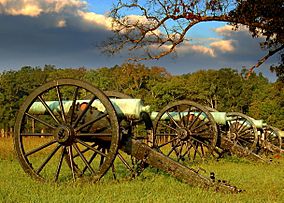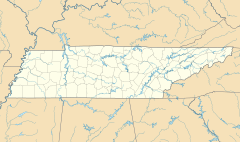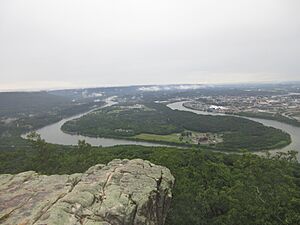Chickamauga and Chattanooga National Military Park facts for kids
Quick facts for kids Chickamauga and Chattanooga National Military Park |
|
|---|---|

Cannon Row
|
|
| Location | Catoosa, Dade, & Walker County, Georgia & Hamilton County, Tennessee, United States |
| Nearest city | Chattanooga, Tennessee |
| Area | 9,523 acres (38.54 km2) |
| Established | August 19, 1890 |
| Visitors | 1,021,822 (in 2023) |
| Governing body | National Park Service |
| Website | Chickamauga and Chattanooga National Military Park |
|
Chickamauga and Chattanooga National Military Park
|
|
| Location | S of Chattanooga on U.S. 27, Fort Oglethorpe, Georgia |
| Built | 1890 |
| Built by | United States War Department, National Park Service |
| Architectural style | Bungalow/Craftsman, Single-pen log cabin |
| NRHP reference No. | 66000274 |
| Added to NRHP | October 15, 1966 |
The Chickamauga and Chattanooga National Military Park is a special place in northern Georgia and southeastern Tennessee. It protects the areas where two very important battles of the American Civil War happened. These battles were the Battle of Chickamauga and the Siege of Chattanooga. The park helps us remember and learn about these historical events.
Contents
History of the Park
How the Park Started
In the 1890s, the United States government decided to create the first four national military parks. These parks were made to remember important Civil War battlefields. Chickamauga and Chattanooga was the very first and largest of these parks.
It was officially opened in September 1895. The park covers about 5,300 acres. Two former Union Army generals, Henry V. Boynton and Ferdinand Van Derveer, worked hard to make this park happen. They wanted to save these battlefields and honor the soldiers.
Another important person was General Henry M. Cist. He led a group called the Chickamauga Memorial Society. Franklin Guest Smith and Charles H. Grosvenor, also former Union officers, helped manage the park in its early years.
Who Managed the Park?
At first, the War Department managed the park. It was used for military training and as a memorial. Later, in 1933, the National Park Service took over. They still manage the park today.
Training During the Spanish–American War
Camp George H. Thomas
The Chickamauga and Chattanooga National Military Park was used for a special purpose during the Spanish–American War. It became a big training center for soldiers from the southern states. The park was even temporarily called "Camp George H. Thomas". This name honored a Union Army commander from the Civil War.
The park was a good choice because it was close to a major train center in Chattanooga. It also had lots of open land for soldiers to train. Troops prepared here before going to places like Cuba.
Areas of the Park
The military park has four main parts. It also includes a few smaller, separate areas around Chattanooga.
- Chickamauga Battlefield
- Missionary Ridge
- Lookout Mountain Battlefield and Point Park
- Moccasin Bend
Protecting Historic Places
On October 15, 1966, the park was added to the National Register of Historic Places. This list helps protect important historical sites across the country.
Moccasin Bend Unit
On February 20, 2003, a new part called Moccasin Bend was added to the park. The Moccasin Bend Archaeological District is a very important historical site. It is known for its ancient American Indian settlements.
Moccasin Bend is located right across the Tennessee River from Lookout Mountain. Today, visitors can enjoy two hiking trails there. These are the Blue Blazes Trail and the Browns Ferry Road. There is also a ten-acre meadow open to the public. The park plans to add more visitor services and restore the land in the future.
See also





